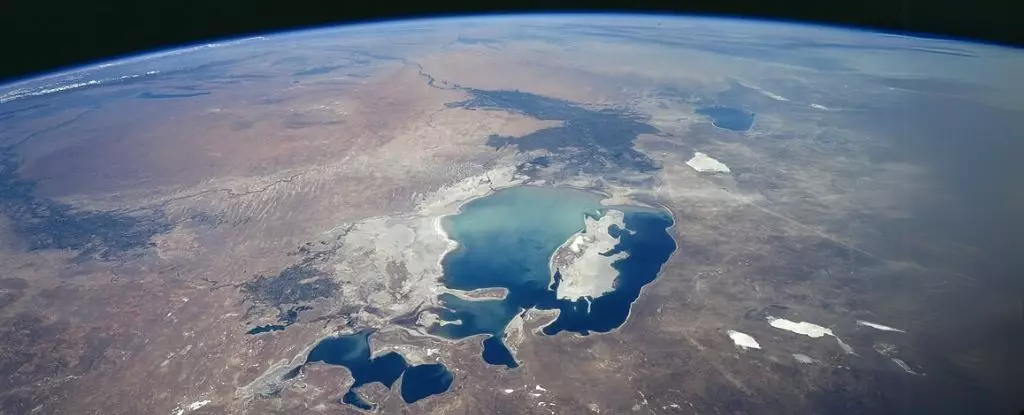In the decades leading up to the 1960s, the Aral Sea stood as the fourth largest lake on the planet, its shimmering waters reflecting the contrasting landscapes of Uzbekistan and Kazakhstan. This vast body of water, which once covered an expanse of approximately 68,000 square kilometers (26,000 square miles), was an essential resource for the millions who inhabited the surrounding areas. However, by 2015, this once-thriving lake had transformed into a desolate ghost of its former self, diminishing to a mere fraction of its size—around 8,000 square kilometers. The remaining landscape, now known as the Aralkum desert, serves as a grave reminder of humanity’s impact on the environment and the dire consequences of neglecting ecological balance.
The story of the Aral Sea’s decline is rooted in misguided agricultural practices that date back to the Soviet era, particularly between the 1960s and 1990s. During this time, the diversion of the Amu Darya and Syr Darya rivers—once vital arteries supplying water to the Aral Sea—was part of an extensive irrigation strategy aimed at cultivating vast cotton fields across Central Asia. Over 7 million hectares (around 1.7 million acres) were transformed to support the Soviet cotton industry, leading to an unsustainable siphoning of the rivers’ flows. As these water sources dwindled, the Aral Sea began its relentless retreat, ultimately splitting into fragmented bodies of water devoid of life.
The severe consequences of this mismanagement were not merely environmental. The collapse of the Aral Sea’s ecosystem triggered a cascade of social and economic disruptions. Fishing, once a thriving industry, became untenable, leaving communities scrambling to adapt to new realities. Rusted fishing boats now dot the barren beaches, haunted monuments to an industry that once flourished.
The ecological ruin of the Aral Sea has extended far beyond its immediate vicinity, affecting air quality and public health across a broad geographic range. The transformation of the lakebed into the Aralkum desert witnessed a surge in airborne particulate matter, significantly increasing atmospheric dust levels. Studies reveal a nearly twofold rise in atmospheric dust from 1984 to 2015, with the region’s dust emissions skyrocketing from 14 million to 27 million metric tons.
What sets the dust from the former lakebed apart is its toxicity. Contaminants from legacy USSR chemical weapons testing and agricultural runoff have laden the dust particles with potentially dangerous compounds. As storms sweep across the landscape, this toxic dust is spread over vast areas, wreaking havoc on agricultural production and contaminating drinking water sources. Farmers located hundreds of kilometers away find their crops damaged and their livelihoods threatened.
The health ramifications for the people living near the Aral Sea are grave. Rising instances of congenital defects, respiratory diseases, and other health issues have been reported, with both adults and children suffering the consequences of prolonged exposure to the toxic dust. The societal implications of this public health crisis are staggering, forcing families to confront a dual challenge: struggling for survival in an ecologically devastated landscape while also navigating the health repercussions of their environment.
The plight of the Aral Sea represents a cautionary tale, illustrating the necessity of prioritizing sustainable natural resource management. The tragedy unfolding in this region is not confined to Central Asia; similar situations are emerging worldwide. From shrinking lakes in Africa and Europe to dwindling waterways in Australia and the United States, the repercussions of industrialized agriculture and inadequate water management are becoming increasingly evident.
To counteract the impacts of this environmental crisis, regional governments have initiated efforts to restore the former lakebed through the reintroduction of vegetation, aiming to mitigate the spread of hazardous dust. International organizations like the EU and USAID have recognized the dire situation and offered support, yet the uncertainty surrounding the future of these initiatives underscores a significant challenge.
The decline of the Aral Sea serves as an urgent reminder of the interconnectedness of human activity and ecological balance. The lessons learned from this tragic environmental disaster must galvanize global action to safeguard water resources and prioritize sustainable ecosystems. Without a commitment to responsible stewardship, the fate of the Aral Sea could become a grim narrative retold across various regions around the world.


Leave a Reply